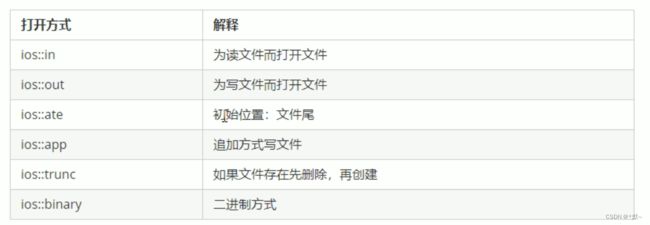文件的相关概念及用法
文件的作用
程序运行时产生的数据都属于临时文件,程序一旦运行结束就会被释放。若想让数据保存下来,则可以通过文件将数据持久化
文件需要包含的头文件
文件分类
文件分为文本文件和二进制文件。
文本文件:文件以文本的ASCII码形式存储在计算机中
二进制文件:文件以文本的二进制形式存储在计算机中,用户一半不能直接读懂它们。
操作文件的三大类
1、ofstream(output file stream--输出文件流):用于写操作
2、ifstream(input file stream--输入文件流):用于读操作
3、fstream(file stream--文件流)用于读写操作(即可读可写)
文本文件
写文件
写文件包含步骤:
1、包含头文件
#include
2、创建流对象
eg:ofstream/fstream ofs;
3、打开文件
ofs.open("文件路径",打开方式);
4、写数据
ofs<<"写入的数据";(类似于output)
5、关闭文件
ofs.close();
文件打开方式
例如:用二进制方式写文件:
ios::binary | ios::out
eg:
#include
using namespace std;
#include
#include
int main()
{
ofstream ofs;
ofs.open("text", ios::out);
ofs << "姓名:张三" << endl;
ofs << "性别:男" << endl;
ofs.close();
system("pause");
return 0;
} 读文件
读文件步骤与写文件步骤相似,分为:
1、包含头文件
2、创建流对象
3、打开文件并判断是否打开成功
4、读数据(有四种读取方式)
5、关闭文件
eg:
#include
using namespace std;
#include
#include
int main()
{
ifstream ifs;
ifs.open("text.txt", ios::in);
if (!ifs.is_open() )//ifs.is_open()执行结果:若当前路径下存在文件名为text.txt的文件,则返回true,否则返回false
{
cout << "此文件不存在" << endl;
}
else
{
//读数据
//第一种
/*char buf[1024];
while (ifs >> buf)
{
cout << buf << endl;
}*/
//第二种
/*char buf[1024];
while (ifs.getline(buf, sizeof(buf)))
{
cout << buf << endl;
}*/
//第三种
string buf;
while (getline(ifs, buf))//从ifs中读取一整行的数据,放入buf中
{
cout << buf << endl;
}
//第四种:逐字符读取,不推荐
//关闭文件
ifs.close();
}
return 0;
} 二进制文件
即以二进制的方式对文件进行读写操作
打开方式要指定为ios::binary
写文件
二进制方式写文件主要利用流对象调用成员函数write
函数原型:
ostream& write(const char* buffer,int len);
参数解释:字符指针buffer指向内存中一端存储空间,len是读写的字节数
eg:
#include
using namespace std;
#include
//将一个person类写入二进制文件中
class person {
public:
char name[64];//由于二进制文件写文件底层原理是用C实现的,因此此处用字符数组而不是string,防止出现问题
int age;
};
int main()
{
//1、包含头文件 2、创建流对象
ofstream ofs("person.txt", ios::out |ios::binary);//ofstream底层有一个有参构造函数,因此可以将第三步合并到第二步
// 3、打开文件
//ofs.open("person.txt", ios::out|ios::binary);
// 4、写文件
person p = {"张三",18};//实例化对象p
ofs.write((const char*)&p, sizeof(person));//第一个参数:&p--返回的是person*,再将person*强转成write需要的const char*
// 5、关闭文件
ofs.close();
return 0;
} 读文件
二进制方式读文件主要利用流对象调用成员函数read
函数原型:
istream &read(char* buffer,int len);
参数解释:字符指针buffer指向内存中的一段空间,len是读写的字节数
eg:
#include
using namespace std;
#include
//将一个person类写入二进制文件中
class person {
public:
char name[64];//由于二进制文件写文件底层原理是用C实现的,因此此处用字符数组而不是string,防止出现问题
int age;
};
int main()
{
//1、包含头文件 2、创建流对象
ifstream ifs("person.txt",ios::in |ios::binary);
//3、打开文件
if (!ifs.is_open())//打开文件失败
{
cout << "person.txt不存在" << endl;
}
else
{
//4、读文件
person p;//实例化对象p
ifs.read((char*)&p, sizeof(p));//将文件中的数据读入p中
cout << "姓名:" << p.name << "\t" << "年龄:" << p.age << endl;
// 5、关闭文件
ifs.close();
}
return 0;
}
